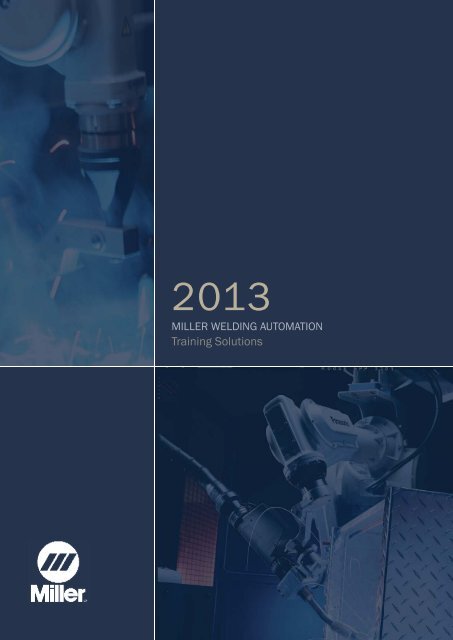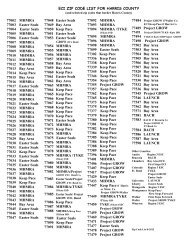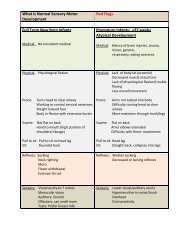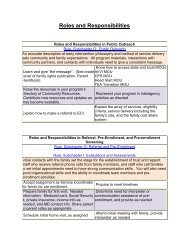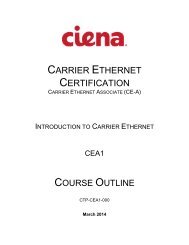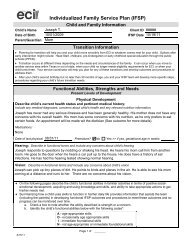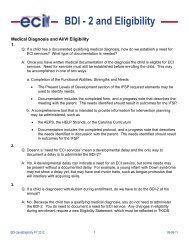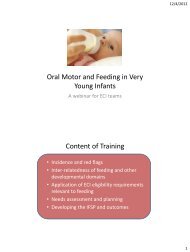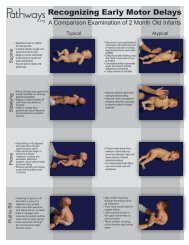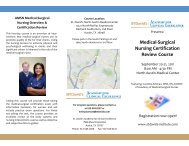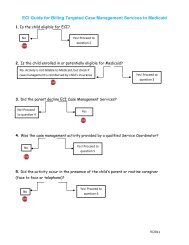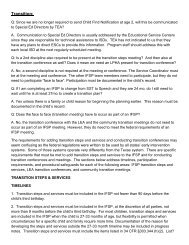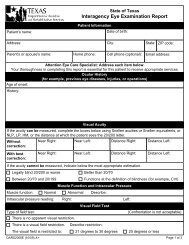Training Solutions - ABC Signup
Training Solutions - ABC Signup
Training Solutions - ABC Signup
- No tags were found...
You also want an ePaper? Increase the reach of your titles
YUMPU automatically turns print PDFs into web optimized ePapers that Google loves.
2013MILLER WELDING AUTOMATION<strong>Training</strong> <strong>Solutions</strong>
Contents<strong>Training</strong> Process. . . 6<strong>Training</strong> Center . . . . 8Case Study . . . . . . . 10Registering . . . . . . . 12Course Overview. . . 14Custom <strong>Training</strong> . . . 18<strong>Training</strong> Assets . . . . 202 2013 Miller Welding Automation www.millerwelds.com
Contact InformationJames Manning PH: 630-653-6819Miller Automation Email: james.manning@millerwelds.com281 E Lies RdCarol Stream, IL 60188United States3750B Unitt 1, Laird RdMississauga, ON L5L 0A6Canada2013 Miller Welding Automation3
<strong>Training</strong> ProcessWhat you should know…All of the courses developed and presented by the Miller Welding Automation <strong>Training</strong>Centers are done so with one objective in mind; To Make Using Our Products a ProfitableExperience. Miller Welding Automation understands the principles of successful manufacturing.We’ve been doing it for over 80 years.Successful training, just like successful manufacturing, requires defined and purposefulprocesses. To develop, implement, and evaluate these processes requires in-depthunderstanding of adult learning concepts, goal setting, objective identification, and skillbuilding.“Successful trainingrequires defined andpurposeful process-All of our training staffunderstand these principlesand are certified to developcurriculum and conductcourses using PerformanceBased Equipment <strong>Training</strong>(PBET) guidelines. PBET is aninstructional design methodthat emphasizes skill buildingusing structured blocksof information to facilitatethe learning process. Whenes..”a course is developed usingPBET, it becomes a road mapto successful acquisition ofthe knowledge and skillsrequired for the student to perform their jobs at the highest level.Objectives are set for each training module and relate directly to a skill or block ofknowledge requiring mastery for successful completion of a task, e.g. program generation,nozzle removal, fault isolation, etc. The skill or block of information is demonstratedor taught and then the student must demonstrate their proficiency of the skill or masteryof the concept. Only then does the student move to the next level of training. Typically,the next level builds upon the knowledge or skills previously learned. This stair-stepapproach continues until the student demonstrates their competency and is proficient inthe operation, programming, and maintenance of the equipment.All of this effort is in support of one objective; to ensure your employees have the necessaryskills and knowledge to make YOU profitable.4 2013 Miller Welding Automation www.millerwelds.com
Miller <strong>Training</strong> <strong>Solutions</strong>9%13%20%Thank you for choosing Miller Welding Automation productsand recognizing effective technical training is a key elementof the manufacturing process. It is our most sincere hope youfind the training to be engaging, effective, and ultimatelyprofitable.That’s why we go to great lengths to provide you with thebest training possibleMaximizing Your Profitability is Our Goal!The following pages contain information regarding:• Miller Welding Automation <strong>Training</strong> Courses20142015• How to Schedule <strong>Training</strong> Classes• Course overviews & Student Skills Check Lists• Customized Courses and Onsite <strong>Training</strong>Growing your business throughinnovative training solutions.If you have questions, please feel free to contact us. Additionalinformation may also be viewed on our Website at www.millerwelds.com/automation2013 Miller Welding Automation5
<strong>Training</strong> Center281 E Lies Rd CarolStream, IL UnitedStatesThe Miller Welding Automation <strong>Training</strong> and Research Development Center is located in Carol Stream, Illinois, west of Chicagoand approximately 19 miles north of O’Hare international Airport.10%3750B #1, Laird RdMississauga, ONCanada20%60%The Miller Welding Automation Sales and <strong>Training</strong> facility is located in Ontario.6 2013 Miller Welding Automation www.millerwelds.com
Case StudyK-zell Metals Diversifies with Pre-Engineered Robotic Welding Cells;Achieves Faster Part Start-up,Increased Throughput, ProductionEfficienciesAt a time when manufacturers are lookingfor new ways to diversify and competeagainst global competition, K-zell Metals, Inc.of Phoenix has been proactive in anticipatingchanges in the market through processimprovement. The specialty fabrication andcontract manufacturing business was startedin 1986 by Don Kammerzell, a metallurgicalengineer with more than 40 years experiencein steel fabrication.“About ten years ago, we started gettinginvolved in military work, and rapidly noticed“This was the fastest way toget us in the business.”that our business model was changing frombeing the traditional job shop into a contractmanufacturing facility,” says Kammerzel. “Aswe looked at the work that was out there, wesaw that there was a need for more preciseassemblies in the work that we were doing.We found that if we combined a laser, CNCpress brakes and a robotic welding cell, wecould be much more competitive in the marketplace.The combined precision of the laserand CNC press brakes allowed us to fixtureour parts properly, so robotic welding madea lot of sense.”Through the addition of two MillerPerformArc pre-engineered robotic weldcells, K-zell was able to substantially increaseproductivity (by more than 20 percent),reduce set-up time and find new efficienciesin its welding processes — even on relativelyshort production runs. A modular designallowed each system to be quickly droppedinto the flow of the shop floor, and featuressuch as offline programming have helpedthe company quickly take on new work withminimal start-up time.Implementing a Robotic Welding SolutionAs Kammerzell puts it, “I’m really not afraidof too many metals.” K-zell’s global customerbase requires the company to be well versedin everything from mild steels and HSLAs tostainless and aluminum — the company alsodoes a sizable amount of work with siliconbronze. Much of the work put through itsrobotic cells is parts for military and commercialproducts, ranging from basic mild carbonsteel to 4130 chrome-moly. Run sizes rangeas high as 4,000 to 5,000 parts. Precision iscritical as many of the parts K-zell fabricatesare sub-assemblies that must fit perfectlyinto larger structures. In selecting a roboticwelding solution, K-zell needed a systemsuitable for varying run sizes that couldbe programmed quickly and efficiently, andcould also handle varying thicknesses andtypes of alloys. The two PerformArc cells currentlyat work in the company’s plant are thePA 1100 FW and PA 550 HW with advanced350-amp TAWERS robotic welding systemsfrom Panasonic. (Miller and PanasonicWelding Systems Co., Ltd., entered into astrategic teg partnership in 2010 to form a newbusiness unit within Miller — Miller WeldingAutomation — designed to deliver theseproducts to market as a complete automatedwelding system).200200200201“What we really found was that there was acost advantage to selecting a pre-engineeredsystem because it was already done,” says8 2013 Miller Welding Automation www.millerwelds.com
Kammerzell. “We didn’t need someone to go out and find all of the components and put it alltogether. And no matter what we looked at, this was the fastest way to get us in the business.”Pre-engineered weld cells can be dropped into existing workflows and put into operationwith much of the basic tooling your manual welders are already using. With three mechanicalengineers on staff, K-zell builds all of its own quick-change tooling and fixtures, a featurethat helps the company adjust to product runs of all sizes and quantities. Each cell features afully welded frame and comes pre-wired and pre-assembled (the PA 1100 FW comes in threesections that can be joined with quick assembly and connection capabilities). The cell is completelyintegrated and can be easily relocated by disconnecting the utilities and moving it toa new location.“One of the primary advantages to us was lead time,” says Kammerzell. “We were able to orderit and knew that we were going to have it come in and sit on the floor and we could getgoing with it right away. We looked at the ease of programming and found that this systemwas much easier to program than the robotic cells we had looked at previously. And then welooked at the ability eventually to go to offline programming.”“One of the primaryadvantages to uswas lead time.”According to Jim Benjamin, quality assurance manager and robotic welding supervisor, atK-zell Metals, the design of each cell also allows for nearly 100-percent robot run time. Thepositioners on both the PA 1100 FW (Ferris wheel style) and the PA550 HW (merry-go-roundstyle) create a two-station weld cell.“You have a man loading one part on one side while the robot is working on the other side,”he says. “It’s a continuous arc-on situation. As soon as the table flips out, I’m unloading andloading a new one into the robot, but it’s still working at the same time.”Kammerzell says the design of the cell, with the work being done away from the flow of theshop floor, was an important factor.“The work flows by the cell,” he says, “and it stops just for a moment and moves on. It’s less ofan impediment; it’s more of a sidebar to the flow of work through the shop.”Source: www.millerwelds.com2013 Miller Welding Automation9
Learning by Doing = More Hands OnLearning by doing is the fundamental approach to our training philosophy.Students advance their knowledge through a series of exercises and labswhere they are able to practice and apply each learning objective. Our goalis 80 percent hands-on and 20 percent classroom lecture.80%Our training includes ample training with the robot, and the teach pendant.Unique to Miller Automation training is the number of hours spentwith actual robot welding time; allowing trainees the opportunity to moreclosely mimic the conditions of their work environment.
Course OverviewRobot Operation <strong>Training</strong>The Operations <strong>Training</strong> Course was designed for those with a need to understandthe complete operation and programming of a robotic application, including the robotarm, teach pendant, and controller. This course teaches the skills required to buildyour product using Miller Welding Automation Industrial Equipment, from setup, toprogramming and debug. It includes the troubleshooting of common errors and focuseson stream lining your process with the intended outcomes of minimizing equipmentdown time, minimizing scrap and increasing productivity.A balance of theory and practical hands-on lab time is used to ensure the students’ability to fully understand robot operation and apply skills learned. Robotic weldingwill take place during this course. Safety is a key concern both in the training environmentand production floor and is repeatedly reinforced throughout the program.For special applications such as Touch Sensing, Harmonic Motion, and other advancedwelding software options, please attend the Advanced Robotics Operations courseslisted later in the course overviews section.Prerequisites: noneCourse Length: 4.5 daysTuition: $1,500.00 per studentRe-Certification Credits: 40 re-certification points toward Miller Electric trainingcertifications.20072008201512 2013 Miller Welding Automation www.millerwelds.com
Carol Stream <strong>Training</strong> ScheduleRobot Operation <strong>Training</strong> Schedule 2013Month Start Dates Month Start DatesJanuary 7, 21 July 8, 22February 4, 25 August 19March 4,18 September 9, 23April 8, 22 October 7, 21May 13 November 4, 18June 3, 17, December 9, 16Canada <strong>Training</strong> ScheduleRobot Operation <strong>Training</strong> Schedule 2013Month Start Dates Month Start DatesJanuary 7th July 8thFebruary 4th August 12thMarch 4th September 16thApril 8th October 14th20072008May 6th November 11th2015June 3rd December 16th2013 Miller Welding Automation13
Robot Corrective MaintenanceRobot maintenance training is designed for those with the corrective and preventativemaintenance responsibilities of the Miller Welding Automation robotic equipment.The course stresses the importance of preventive maintenance while providing theskills needed to troubleshoot problems and quickly resolve machine down time. Thestudents develop a thorough understanding of electrical and mechanical componentsby hands on training labs. Minimizing equipment failures and increasing productivityis the goal of this course.Prerequisites: noneCourse Length: 3 daysTuition: $1,700.00 per studentRe-Certification Credits: 40 re-certification points toward Miller Electric trainingcertifications.14 2013 Miller Welding Automation www.millerwelds.com
Carol Stream <strong>Training</strong> ScheduleRobot Maintenance <strong>Training</strong> Schedule 2013Month Start Dates Month Start DatesJanuary 29 July N/AFebruary N/A August 27March N/A September N/AApril 2 October N/A2008May 21 November 122015June N/A December 3Canada <strong>Training</strong> ScheduleRobot Maintenance <strong>Training</strong> Schedule 2013Month Start Dates Month Start DatesJanuary N/A July N/AFebruary 11th August 19thMarch N/A September N/AApril 15th October 21st2008May N/A November N/A2015June 10th December 9th2013 Miller Welding Automation15
Desktop Programming Software (DTPS)This course is designed to instruct the student in the use of the “Offline” programgeneration software. This software allows the development of programs offline minimizingrobot downtime and maximizing throughput and productivity. This specializedsoftware allows the generation of programs and simulates the actual taught pathsfrom your desktop.DTPS training includes four day course at Carol Stream facilities and two 12 hours ofonsite instructor led training.Prerequisites: Basic Operation <strong>Training</strong>Course Length: 4 days classroom/lab + 12 hours onsite with instructor.Tuition: $4,000.00Onsite: 12 hoursRobot Operation <strong>Training</strong> Schedule 2013Month Start Dates Month Start DatesOpen enrollement: Course scheduled per customer needs.16 2013 Miller Welding Automation www.millerwelds.com
Specialized Robot Operation <strong>Training</strong> CoursesThe courses listed below are offered after completion of the operations class describedpreviously. These are not stand-alone courses, attendance requires that thestudent 15% understand the principles of robot operations.The focus of these 1 to 3 day courses is on operating and programming the uniquefeatures of this specialized software and hardware. Great emphasis is placed onpersonnel and equipment safety. The goals of the training are on streamlining productsetup and thus maximizing quality and productivity, while minimizing scrap andequipment downtime.• The courses listed below may be scheduled by contacting the Miller WeldingAutomation <strong>Training</strong> Center at: (630) 653-6819 x5121• External Axis/Harmonic motion(Setup & operation/robotic applications)• 3D Touch sense(Setup & operation/robotic applications)• Arc touch-sense/Seam Tracking(Setup and operation/robotic applications)• Heavy plate process(Setup & operation/robotic applications)• TIG welding process(Basic setup and operation/robotic applications)• MIG-Force(Servo Push/Pull)• AWPPrerequisites: Basic OperationCourse Length: 2 to 3 days20072008Robot Operation <strong>Training</strong> Schedule 2013Class Date # of Days Tuition2015Heavy Plate 2/18/2013 3 $1700TIG Welding 2/21/2013 2 $1300Heavy Plate 6/24/2013 3 $1700Adv. Programming 6/27/2013 2 $1300Heavy Plate 8/12/2013 3 $1700TIG Welding 8/15/2013 2 $1300Adv. Programming 10/14/2013 2 $1300Heavy Plate 10/17/2013 3 $17002013 Miller Welding Automation17
Desktop ProgramingOffline programming and simulation in robotic weldingOffline programming and simulation software allows you to program yourrobot from a computer rather than on the robot itself. To work with this typeof software, you need 3-D CAD models of both your parts and fixtures that willbe used in the cell (created in a program such as SolidWorks®). From thereyour software options will vary depending on the brand of the robots in yourrobotic welding cells.The training is conducted in two phases:Phase I: A four days of classroom training conducted at our Caral Stream office.Phase II: A two days of onsite calibration and integration.Tuition:• $4000 for up to two students for the classroom training.• $1000 per day plus travel expenses to conduct onsite integration18 2013 Miller Welding Automation www.millerwelds.com
DTPS <strong>Training</strong> AgendaTransferring Data from Robot to PC via Flash CardData Management within DTPS (PC Folder)• Transferring Files in and out of DTPS• General layout of DTPS softwareBasic PC Editor (Virtual Robot)• Checking & Setting Robot Information, BasicProgram EditingNOTE: For onsite class each student must have a computer with DTPS installed. MWA can providetemporary copies of DTPS if you own fewer licenses than students.Offline Programming (DTPS G2/G3 -Installation)• Data Structure within DTPS• Drawing Parts in DTPS• Importing CAD files• Setting up a system (InstallationEditor)• External Axis Editor• Offline Programming• Drawing Weld Lines• Programming offline• Cycle Time analysis• Reach Studies• Collision Detection• Calibration of your Robotic WeldingSystem• Aligning Program from DTPS toReal System• Dimension Lines• Additional FeaturesRobot Operation <strong>Training</strong> Schedule 2013Month Start Dates Month Start DatesOpen enrollment: Course scheduled per customer needs.2013 Miller Welding Automation19
Specialized <strong>Training</strong>Customized training - is available for all levels of your manufacturing process. We realizethat the cookie-cutter approach to training is not always optimum for every situation. OurPerformance Based Equipment <strong>Training</strong> certified specialists will be happy to discuss yourneeds and options for providing the right solution for your particular training needs.Onsite <strong>Training</strong> - often proves to be the most financially sound and effective training available,but does require machine time. If you have multiple personnel that need to be trained andhave room in your production schedule to free up equipment for training, please contact thetraining center for a quote.Prerequisite: NoneTuition: $150/hr. plus portal to portal expenses.Days: Based on training scopeLocation: TBD by CustomerRobotic TIG Welding (Gas Tungsten arc welding)This course teaches the process of welding, using atungsten electrode. During the training the studentwill receive instruction and extensive hands-onopportunities to develop the skills required to demonstrateproficiency of TIG welding. TIG welding iscommonly used when high quality precision weldingis required. Custom class and fees.Heavy Plate Welding Software (heavy plate multi-passwelding process)This course teaches students to use the specializedsoftware developed to weld heavy plate, using multipasswelds. The software monitors bead width, height,and number of passes to ensure high quality welds onextremely thick materials. Custom class and fees.20 2013 Miller Welding Automation www.millerwelds.com
Arc Touch Sense / Seam TrackingStudents learn to setup all parameters required forsuccessful arc sensing and seam tracking, ensuringhigh quality welds on even the most inconsistentmaterials. The Arc Sensing and Seam Tracking processesmonitor voltage or current through the torchand identifies material irregularities. Custom classand fees.3D Touch SensingThis course, similar to the above Arc Sense andSeam Tracking course identifies irregularities in allthree axes X, Y, & Z planes. Custom class and fees.External Axis & Harmonic MotionThis course teaches the skills and knowledgerequired to generate robotic welding programsusing external servo driven axis. These externalaxes rotate the work material for easier access toweld joints. Harmonic motion is a software functionthat ties the robot and external axis together tomaintain welding speeds. Custom class and fees.2013 Miller Welding Automation21
<strong>Training</strong> AssetsWithin your organization, we can help you develop productivity specialists by sharing ourunique experience and extensive knowledge. An investment in training is an investment inyour organization that can offer tremendous operations expertise, productivity gains and ROI.We understand that our trainees are hear to learn something and is immediately transferableto their job. Our performance based training methodology is geared towards human performanceand business results and designed with five key principles to ensure that we are meetingthe needs and expectations of our customers.Instructional Design Principles• Clearly defined performance objectives• Practice and feedback• Focus on customer needs• Well equipped training facility• Assessment and measurements22 2013 Miller Welding Automation www.millerwelds.com
1.2.3.4.Clearly defined performance objectives: We designeach course to meet their learning objectives. aswell as meet customer expectations.Ample practice and feedback: each student isassured time with the robots. Our creative lab workallow for better retention and understandingFocus on customer needs: Our courses are flexibleto all instructors the opportunity to address specificcustomer cenerns.Well equipped training facility: The goal is to ensurethat students learn on the equipment that they willuse on the daily basis.“Our PBET methodologyis designedfor humanperformance andbusiness results.”5.Assessment and Measurement: We evaulate eachcourse based on student achievement, studentevaluations and customer feedback.2013 Miller Welding Automation23
MILLER WELDING AUTOMATION281 E Lies RoadCarol Stream, IL 60188630-653-6819www.millerwelds.com


